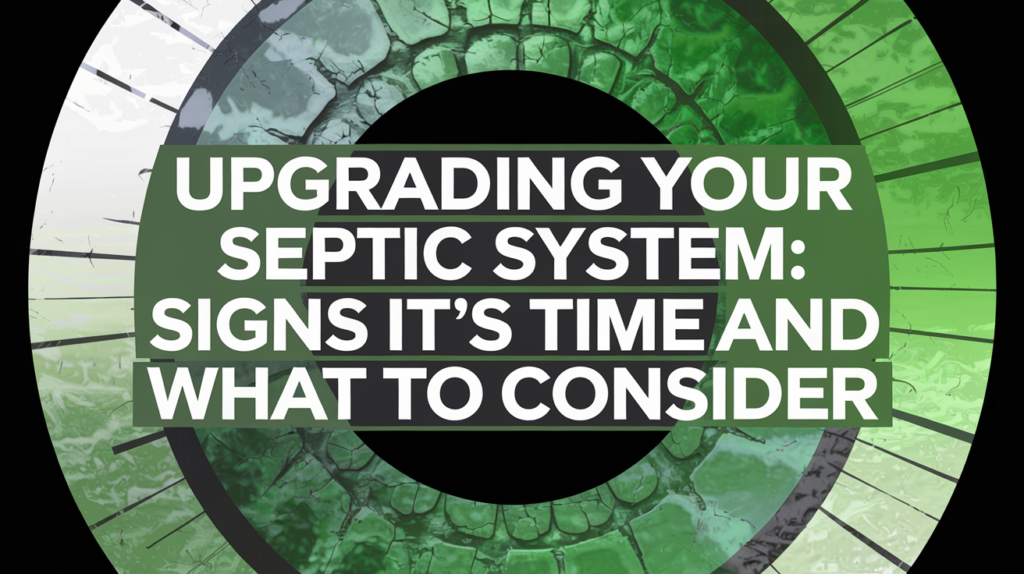As a homeowner, it’s essential to recognize when your septic system may need an upgrade. Whether due to age, increased usage, or property changes, upgrading your septic system can offer numerous benefits, including improved efficiency, reduced environmental impact, and increased property value. In this article, we’ll explore five signs that it may be time to upgrade your septic system and what factors to consider when planning an upgrade.

Sign 1: Frequent Repairs Needed
One of the most obvious signs that your septic system may need an upgrade is the need for frequent repairs. If you find yourself calling for service regularly to address issues like clogs, backups, or leaks, it could be a sign that your system is outdated and struggling to keep up with your household’s needs.
While repairs can help extend the life of your system in the short term, there comes a point when the cost and inconvenience of frequent fixes outweigh the benefits of upgrading to a newer, more efficient system. Consider factors such as:
- The age of your current system
- The severity and frequency of repairs needed
- The cost of repairs compared to the cost of upgrading
- The potential for future problems if upgrades are delayed
By weighing these factors and consulting with a septic professional, you can determine whether upgrading your system is the most cost-effective and practical solution in the long run.
Sign 2: System Age
Another important factor to consider when deciding whether to upgrade your septic system is its age. Most conventional septic systems have a lifespan of 20-30 years, depending on factors such as:
- The quality of installation and materials used
- The level of maintenance and care provided
- The amount and type of usage the system experiences
If your septic system is approaching or exceeding this age range, it may be time to consider an upgrade, even if you haven’t experienced significant problems yet. Older systems are more likely to experience failures, leaks, or other issues that can be costly to repair and pose risks to your property and the environment.
Upgrading to a newer, more advanced system can provide benefits such as:
- Improved efficiency and performance
- Reduced risk of failures or environmental damage
- Compliance with current regulations and standards
- Increased property value and marketability
By being proactive about upgrading an aging septic system, you can avoid the stress and expense of emergency repairs and ensure reliable, efficient wastewater management for years to come.
Sign 3: Increased Water Usage
Changes in your household’s water usage can also be a sign that it’s time to upgrade your septic system. If your family has grown, you’ve added new appliances or fixtures, or you’ve started using more water for activities like gardening or entertaining, your septic system may be struggling to keep up with the increased demand.
Overloading a septic system can lead to problems like:
- Clogs and backups in drains or toilets
- Slow draining or gurgling sounds in fixtures
- Overflowing or flooding of the tank or drain field
- Contamination of groundwater or nearby water sources
To avoid these issues and ensure your septic system can handle your household’s changing needs, consider upgrading to a larger tank, adding more leach field lines, or installing a more advanced treatment system. A septic professional can help you assess your current system’s capacity and recommend the most appropriate upgrades based on your specific situation.
Sign 4: Property Additions
In addition to changes in water usage, physical changes to your property can also necessitate a septic system upgrade. If you’re planning to add a bedroom, bathroom, or other living space to your home, or if you’re considering installing a pool, spa, or other water-intensive feature, it’s crucial to evaluate the impact on your septic system.
Expanding your living space or adding new features can increase the amount of wastewater your septic system needs to handle, potentially exceeding its current capacity. To avoid overloading your system and risking failures or backups, you may need to upgrade to a larger tank, install additional leach field lines, or even replace your entire system with a more advanced option.
When planning property additions or improvements, be sure to:
- Consult with a septic professional to assess your current system’s capacity and upgrade needs
- Obtain necessary permits and approvals from local authorities
- Plan upgrades in conjunction with your property changes to minimize disruption and ensure seamless integration
By proactively addressing your septic system’s needs as part of your property improvement plans, you can ensure reliable, efficient wastewater management and avoid costly surprises down the road.
Sign 5: Environmental Concerns
Finally, upgrading your septic system can also be motivated by a desire to reduce your environmental impact and adopt more eco-friendly wastewater management practices. Traditional septic systems, while effective, can have limitations in terms of treatment efficiency and nutrient removal, which can contribute to groundwater contamination and other environmental issues.
Upgrading to a more advanced, eco-friendly septic system can offer benefits such as:
- Improved treatment efficiency and higher-quality effluent
- Reduced nutrient pollution and protection of local water resources
- Smaller footprint and less disruption to natural landscapes
- Compliance with stricter environmental regulations
- Increased property value and appeal to environmentally conscious buyers
Some eco-friendly septic system options to consider include:
- Aerobic treatment units (ATUs) that use oxygen to break down waste more efficiently
- Recirculating sand filters that provide advanced filtration and nutrient removal
- Constructed wetlands that mimic natural water purification processes
- Drip irrigation systems that disperses treated effluent slowly and evenly over a large area
By upgrading to a more environmentally friendly septic system, you can reduce your impact on the environment, protect local water resources, and demonstrate responsible stewardship of your property.
Conclusion
Recognizing the signs that it’s time to upgrade your septic system is crucial for maintaining effective, efficient wastewater management and protecting your property and the environment. Whether motivated by frequent repairs, system age, increased water usage, property additions, or environmental concerns, upgrading your septic system can offer numerous benefits and peace of mind.
When considering a septic system upgrade, be sure to consult with a qualified professional who can assess your current system, recommend appropriate upgrades, and ensure proper installation and integration with your property. For more information on the importance of professional septic installation and how to choose a qualified contractor, check out our article on “Why Professional Septic Installation is Essential: Risks of DIY and How to Choose a Qualified Contractor” coming soon.
By staying proactive and informed about your septic system’s needs and upgrade options, you can ensure reliable, sustainable wastewater management for your home and protect the health and value of your property for years to come.

